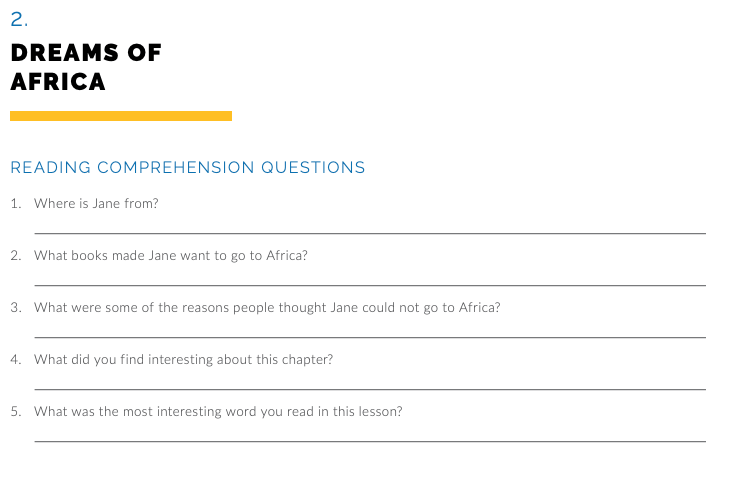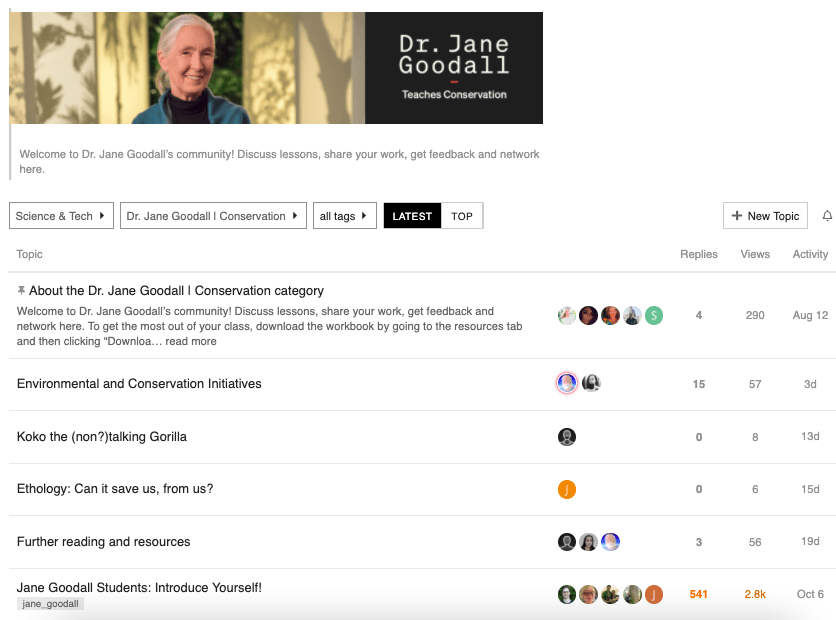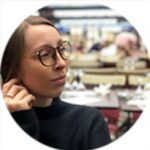Jane Goodall MasterClass review synopsis
What you’ll learn: In this MasterClass, you’ll learn about the extraordinary life of Dr. Jane Goodall, the ins and outs of conservation, and how you can do your part in protecting our planet.
How long does the Jane Goodall MasterClass take? 5 hours and 6 minutes.
Similar Courses: Jessie Krebs Teaches Wilderness Survival, Neil deGrasse Tyson Teaches Scientific Thinking and Communication, Ron Finley Teaches Planting your our own food, Brandon McMillan Teaches Dog Training
Do I recommend Jane Goodall’s MasterClass? Yes, the course is a great way to learn more about our planet, the animals that live on it, and how we can do our part to protect it.
With the current state of the climate crisis, you would have to be living under a rock not to be concerned about our planet’s future.
So signing up for this MasterClass, I was excited to listen to what Dr. Jane Goodall had to say about conservation.
She lived with and studied chimpanzees in the 60s and 70s, which inspired her to fight for the conservation of the natural habitat of all animals. In 1997, after decades of activism, she won the Tyler Prize for Environmental Achievement.
It’s fair to say she’s one of the most renowned conservationists of the last century.
Early in the course, Dr. Goodall talks us through her early years studying chimpanzees in Gombe, explaining her life, philosophy, and morals. Later, she offers practical advice for living a more sustainable life and protecting our planet as much as we can.
Without any question, we are the most intellectual creature that’s ever walked on planet earth. How is it possible that we’re destroying our only home?
– Lesson 10, Humans & The Environment
Goodall tackles vast and overwhelming topics like climate change and poverty in a very refreshing way. She keeps things light and engaging, often using comedic stories to illustrate her points.
In this review, we’ll break down exactly what Jane Goodall’s MasterClass covers, how much it’ll cost you to take the course, and whether it’s worth the money.
Disclosure: In the interest of full transparency, Codeless uses affiliate links in our MasterClass reviews to cover our site’s costs.
Our Verdict
I’d recommend this MasterClass to anyone who wants to know more about conservation and how we can play a part in saving our planet.
Jane Goodall MasterClass Become a better conservationist
PROS
- The person behind the course is a decades-long conservationist with unique credentials.
- It features an interesting exploration of animal behavior.
- There’s actionable advice about sustainable living and conservation.
CONS
- The course is too basic for experienced conservationists.
- Sometimes the focus falls too heavily on sharing insightful stories rather than providing actionable advice.
In this MasterClass review, you’ll learn:
A few frequently-asked questions…
First things first, let’s cover a few of the most common questions about the Jane Goodall MasterClass.
Do I need a subscription to access this course?
Yes, you need a MasterClass subscription to take this course. Prices start at $180 for the year (more on this later).
How long is the MasterClass?
The course consists of 29 video lessons that last for 5 hours and 6 minutes.
Does MasterClass have a cancellation policy?
Yes, you can cancel at any time. If you cancel within the first 30 days, you get a full refund.
Is the Jane Goodall MasterClass worth it?
Yes, it’s worth it. It’s a thrilling exploration of the philosophies and values of Dr. Jane Goodall and a great way to learn more about what we can do as individuals to save our planet. Not to mention, her stories about chimpanzees are pretty awesome.
Check out our complete MasterClass review.
About Jane Goodall
Dr. Jane Goodall is a British ethologist and conservationist. She’s best known for her in-depth study of chimpanzees, which revolutionized our understanding of animal behavior.
She has an extensive list of over 25 published works. These include In the Shadow of Man (1971), The Chimpanzees of Gombe: Patterns of Behavior (1986), and her latest book, The Book of Hope (2021), co-written with Douglas Abrams.

Throughout her career, she has worked tirelessly on environmental conservation and animal welfare issues. As a result, she’s earned a variety of accolades — she was named a UN Messenger of Peace in 2002 and became Dame Commander of the Most Excellent Order of the British Empire in 2004.
She’s also the founder of the Jane Goodall Institute, a charity organization that promotes the wellbeing of local communities, animals, and the environment.
And in 2021, she’s still going strong, with her Roots and Shoots program active in 50+ countries worldwide.
How much does Jane Goodall’s MasterClass cost?
If you want to take the Jane Goodall MasterClass, you’ll need to register for a MasterClass subscription.
There are three annual pricing options you can choose from:
- Standard ($180)
- Plus ($240)
- Premium ($276)
Below is a breakdown of what each plan includes:

There’s no free trial, but you can cancel your subscription within the first 30 days and get a full refund.
With any of these plans, you get access to the whole MasterClass library — over 100 different courses from world-class experts, with more being added all the time. You can, for example, learn more about environmentally-friendly farm-to-table cooking from the Alice Waters MasterClass.
Learn more about MasterClass pricing.
What’s included in the Jane Goodall MasterClass?
Runtime: 5 hours and 6 minutes
Course Value: 5/5
Lessons: 29 video lessons
Supplementary materials: Two workbooks (A standard workbook and a family workbook)
Supplementary workbook
Jane Goodall’s MasterClass comes with two workbooks: a standard workbook and a family workbook.

The standard workbook (93 pages) is for individuals, while the family workbook (164 pages) is perfect for learning with children.
Both workbooks include reviews of each video lesson. They have suggestions on further reading and activities you can do to live more sustainably, such as tracking your water usage or taking part in a seed exchange.

In contrast to the standard workbook, the family workbook has quizzes scattered throughout for children to take part.

The MasterClass Hub
Like all courses, Jane Goodall’s also has a MasterClass Hub — an online forum for users to ask questions and share their experiences with the class.
The Jane Goodall Hub is pretty active. Every week, users ask questions about conservation, share information and ideas about sustainability, and discuss chimpanzee behavior.

There’s even a thread where users share updates about new laws relating to conservation.
A complete breakdown of the Jane Goodall MasterClass curriculum
The entire Jane Goodall MasterClass consists of 29 lessons. Here’s what each video entails:
Curriculum:
- Introduction
- Dreams of Africa
- The Breakthrough
- Chimpanzee Behavior
- Chimpanzee Behavior (Cont’d)
- Chimpanzee Development & Learning
- Animal Intelligence
- Chimps & Humans
- Chimps & Humans (Cont’d)
- Humans & The Environment
- Humans & The Environment (Cont’d)
- Threats to Animals
- Animal Cruelty
- Climate Change
- Water
- Land
- Industrial Agriculture
- Organic Farming
- Food As Activism
- Advocacy Struggles
- Communication
- Communication (Cont’d)
- Opening a Dialogue
- The Next Generation
- Making Global Change
- Roots & Shoots
- Roots & Shoots (Cont’d)
- Reasons for Hope
- Reasons for Hope (Cont’d)
Course summary:
The course starts with an overview of Goodall’s background, including her first experience with wildlife when she was 18 months old. She recalls her mother telling her that she took earthworms to bed with her, soil and all.

Fortunately for Goodall, her mother encouraged her early interest in animals.
After finishing school, Goodall eventually got a job as a secretary for Lewis Leakey, an esteemed archaeologist and paleontologist. And that’s where her journey with Chimpanzees began.
Chimpanzees and animal behavior
Seeing her interest in animals, Leakey sent Goodall on a six-month expedition to Tanzania. Goodall stayed in Gombe to watch and record chimpanzees in their natural habitat.
During this time, Goodall explains that she learned a lot about their behavior. In fact, she was the first to see a chimpanzee (named David Greybeard) use a tool to get food.

She even tells the story of trying to give David Greybeard a nut. To show her he didn’t want it, he knocked it out of her hand and squeezed it for reassurance. A sort of “thanks, but no thanks.”

Goodall explains that human DNA structure differs by just over 1% with chimpanzees, so we share many similarities in the way we behave.
I knew chimpanzees were smart, but I had no idea how smart until taking this course.
Animal cruelty
In 1986, Goodall attended the first ‘Understanding Chimpanzees’ conference. Although she cites the conference as an incredible and exciting opportunity, what she discovered was shocking: animal testing in medical laboratories.
Talking about the conference, she says:
“I went to that conference as a scientist with a wonderful life, planning to continue to go on learning about chimpanzees in Gombe. Without making any conscious decision, I left as an activist.”
– Lesson 10, Humans & The Environment
And just like that, she starts her journey as a climate activist and conservationist.
Conservation and the climate
Goodall explains that the western world has become too materialistic. As a result, we’re disconnected from nature, which puts us out of touch with the damage done every day.

Goodall is very good at breaking down mind-boggling and overwhelming concepts into digestible information.
For example, she outlines three main areas that are problematic for our environment:
1. Extreme poverty
With extreme poverty happening worldwide, many people have to buy the cheapest food options available. More often than not, the affordable options are unsustainably sourced — factory farms, fish farms, etc.
2. Unnecessary waste
Most of us have an unsustainable lifestyle. We buy more than we need and waste more than we should. Goodalls says that if we paid more for our food, we’d think more about wasting it.
3. Human population growth
Too many people use fossil fuels and resources that we can’t replenish. To create a sustainable future, we need to reduce population growth, so our resources aren’t stretched so thin.
To give you some idea of how you can make a difference in these areas, Goodall shares some personal stories that you can adopt into your own life. For instance, a friend of hers stores rainwater to water plants throughout the dry season.
There are various tips and suggestions she offers with ways that we can support the environment. And she’s very vocal about the fact that everyone can make a difference, no matter how small.
Her conservation and climate efforts
Goodall closes the course by discussing some of her climate and conservation efforts, namely her Roots and Shoots program.

Roots and Shoots is a youth program that’s currently active in over 50 countries. It encourages young people to create initiatives to support their local community and improve the environment.
In the last video, Goodall reminds us that there’s still hope out there. She places a lot of onus on younger generations, saying that their interest and passion for enacting change gives her hope for the future.
What I learned
There was a lot of information to digest in this MasterClass, but here are my top five takeaways that stuck with me after the course.
5 takeaways from this MasterClass
1. Goodall revolutionized animal behavior studies
Goodall was the first person to study Chimpanzees in their natural habitat for an extended period. As a result, her studies showed us so much about chimpanzee behavior that scientists at the time thought impossible. For example, their ability to feel emotions and have personalities.
2. Individuals can make a difference
When we think about the climate crisis, it’s easy to feel like our efforts won’t make a difference. Goodall shows us that this isn’t the case, illustrating how the smallest individual action can impact our environment.
3. Conservation is about people
Goodall is adamant that conservation must include local people. All of her conservation efforts involve talking to people who live in areas that need protecting, asking them what would make their lives better and using that as a starting point.
4. Education is key
To understand what’s going on in the environment and make a meaningful difference, you need education. That’s the starting point. Educate yourself, and the rest will follow.
5. Facts are important
If you’re discussing the effects of climate change or the importance of conservation, make sure you know your facts. Find the most recent information and reports to back up your claims. If you don’t, there’s a chance someone will discredit your entire point of view.
Learn your own lessons from Jane Goodall’s MasterClass.
Memorable quotes from this MasterClass
“I think one of the first things that was very exciting for me was seeing how much of their behavior resembled our own.”
– Lesson 8, Chimps and Humans
“I believe that intuition is a very important part of science because that gives you an idea. And once you’ve got that idea, then you can decide to prove or disprove it in a scientific way.”
– Lesson 9, Chimps and Humans (Cont’d)
“How on earth can we think there can be unlimited uneconomic development on a planet with finite natural resources?”
– Lesson 10, Humans & The Environment
“They’re not just things. They are sentient and sapient. And the sooner we learn that, the better.”
– Lesson 13, Animal Cruelty
“I believe, honestly and truly, it’s only when we learn to operate with head and heart in harmony that we can achieve our true potential.”
– Lesson 14, Climate Change
“What can we do? Well, first of all, we need to understand that what we do makes a difference.”
– Lesson 15, Water
“One of the big problems in agriculture today is that companies are trying to grow more food more quickly.”
– Lesson 16, Industrial Agriculture
“One of the ways that we can help the environment by choosing what to buy, by thinking about where it came from.”
– Lesson 18, Food as Activism
“If you don’t talk to people, and if you don’t try and find a way to communicate at some level, how can you expect there to be change?”
– Lesson 23, Opening a Dialogue
Jane Goodall Masterclass pros and cons
Although I’d say the course is definitely worth your time and money, it’s not perfect. Take a look at the pros and cons to see for yourself.
Pros
- The person behind the course is a decades-long conservationist with unique credentials.
- It features an interesting exploration of animal behavior.
- There’s actionable advice about sustainable living and conservation.
Cons
- The course is too basic for experienced conservationists.
- Sometimes the focus falls too heavily on sharing insightful stories rather than providing actionable advice.
Do I recommend this Masterclass?
Although this course is too basic for experienced conservationists, I’d recommend this MasterClass to anyone who wants to know more about conservation and how we can play a part in saving our planet.
I also recommend it if you’re the least bit interested in Jane Goodall’s life story and her unique relationship with chimpanzees and nature at large.



